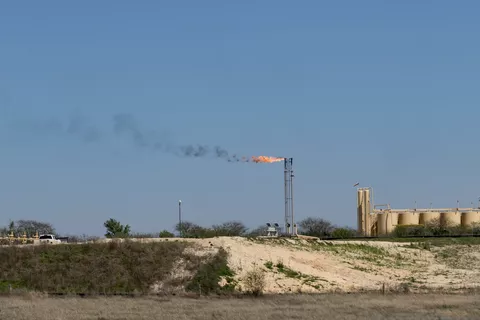
Oil and gas fracking in the Eagle Ford Shale area. Photo by Al Braden.
By Alex Ortiz
Unfortunately, Texas has a lot of fracking and not a lot of water. So the state started looking at possible uses of produced water, which is the wastewater that is left over from the fracking process. This is controversial because we know far too little about what’s in produced water and how it might harm people and the environment.
It’s been a while since we’ve had anything to say about produced water because the Texas Produced Water Consortium has been working over the last year since the Legislature created it and required a report on the future of using produced water to supplement Texas’s ever-rising water demand.
Over the course of that year, the consortium has had countless virtual meetings and one in-person meeting to prepare this report for the Legislature. As an organizational member of the consortium, we’ve been actively participating on multiple subcommittees and consistently striving to push the consortium to consider the potential human health and environmental impacts of putting produced water into the environment. The consortium finished its report earlier this month.
The Good
The report shows some promise by acknowledging that:
- “There is still a need for continued and advanced testing and analysis … before verifying or recommending their application for beneficial use outside of the oil & gas industry.”
- The research presented does not indicate standards for treatment or end-use-water quality — but rather should serve as baseline education. This is crucial, as human health and the environment must be the primary driver of creating standards, followed by a fitness-for-purpose, like construction or irrigation.
- State agencies will need substantial capacity to evaluate and establish standards. We reiterated this in our comments to the Legislative Budget Board, which approves budget requests for state agencies. State funding should primarily fund this role in the development of pilot projects – and we are glad to see support for bolstering the staff at the Texas Commission on Environmental Quality (TCEQ) and the Railroad Commission (RRC) so that these agencies can effectively conduct and supervise risk assessment that ensures the pilots will protect human health and the environment.
The Bad
The report still raises some concerning points, including:
- A policy recommendation that the Legislature encourage the Texas Water Development Board and Regional Water Planning Groups to consider produced water as “available projects.” This would allow these projects to be included in the state water planning process, and therefore eligible for State Water Implementation Fund for Texas (SWIFT) funds, when there is currently no proof that they are economically feasible or environmentally responsible. Substantial risk assessment must still be done on the chemicals found in site-specific produced water. The state should only include produced water projects when they are proven to be safe and effective methods of supplementing Texas’s water supply.
- Moreover, SWIFT funding currently falls short of its 20% goal for conservation and reuse projects. Those projects must be the focus of SWIFT dollars, and produced water is not ready to be considered “reuse” as the state doesn’t yet have the standards or capability to reuse produced water safely.
The Ugly
The report notes a divide among consortium membership regarding the two phases of pilot projects. Evidently, some are interested in studying technology and developing standards while simultaneously applying that produced water to native rangeland, cotton, and even edible crops. This is a concerning red flag.
Putting any treated produced water into the environment in this way would be clearly inappropriate prior to conducting the necessary and substantial risk assessment through Phase 1 pilot projects. Native rangelands often include habitat to threatened and endangered species, as well as other protected wildlife; and there may be detrimental impacts on soil health and public health that are yet to be understood.
To even entertain the idea of studying the treatment of produced water and simultaneously putting it out into the environment would be wholly irresponsible.
What’s Next
Ultimately, the report’s conclusions seem to lean positive. It clearly indicates there’s more work and research to be done. It’s likely that the report will form the basis of legislation in the upcoming 88th Legislature — and we hope that such legislation will align clearly with the needs of the public for risk assessment. Produced water may, at some point, be an opportunity to minimize the harmful impacts of Texas’s already devastating fracking industry. But Texas must first make sure produced water is safe to use and focus on ultimately decreasing our reliance on fossil fuels.